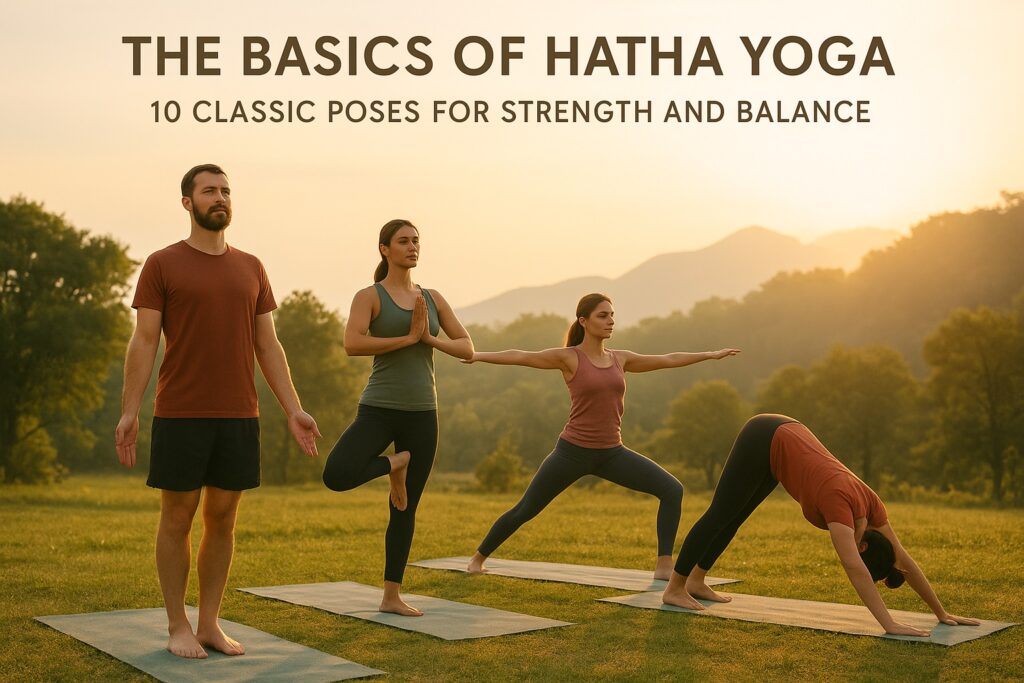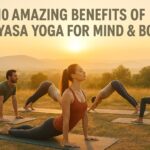Hatha yoga is where the journey of most of the yoga enthusiasts begins. It is the fundamental branch of yoga which majorly focuses on asanas, breathing synchronization, and better alignment. It is one of the oldest yoga forms to exist, dating back to 2000 years ago. Hatha yoga works with both, mindful yielding which means balance and muscle engagement which means focusing on strength. If you wish to have strength that is not flashy but steady and long lasting, then this is the perfect yoga form to practice.
In this blog, you will be learning about how Hatha yoga is so effective and why people prefer to practice it more. Practice these poses and teachings consistently to notice the changes in your daily movements. All the detailed information of the basics of Hatha Yoga are mentioned here, which will help you to form the best foundations of your practice.
What is Hatha Yoga?
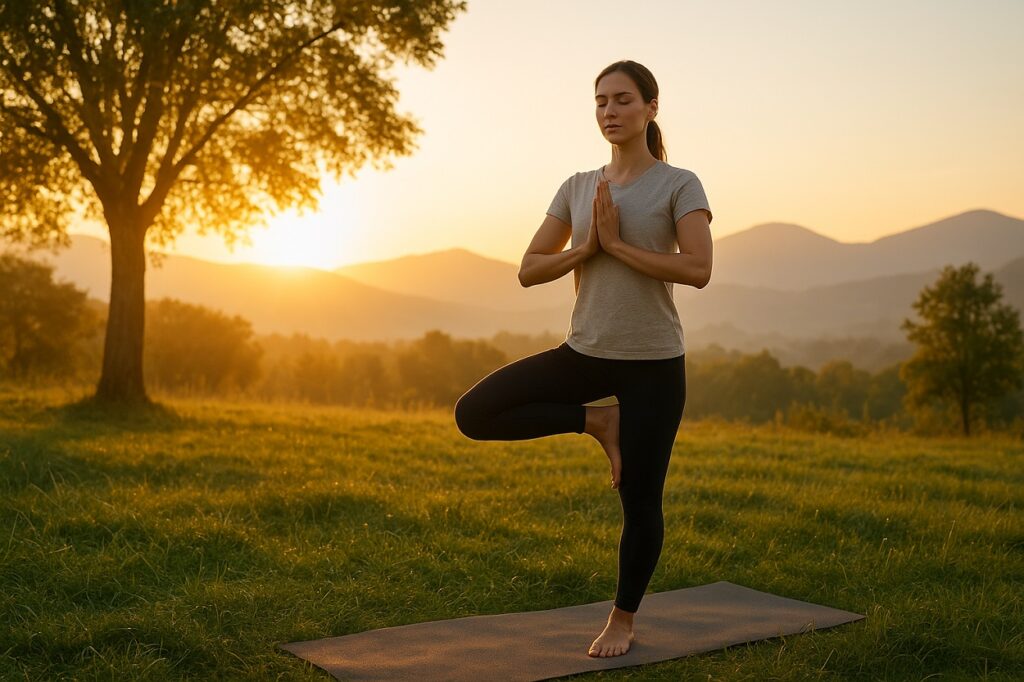
Hatha name is taken from two Sanskrit words, “Ha” meaning the sun and “Tha” meaning the moon. The meaning of this yoga form is not literal to the words but represents it symbolically, the sun represents active and energizing principle whereas the moon symbolises receptive and calming principle. The traditional Hatha yoga is practiced by equally balancing these two forces in order to make your body feel strong and steady.
Hatha yoga is a slow paced style that focuses on holding a particular pose for longer durations. It helps in improving alignment, awareness, and muscle engagement. This is the reason why Hatha is preferred as a foundational yoga style to teach. It not only moves your body but also trains your mind. The stillness you foster within you on the mat also assists your decision in your daily life, which makes you more aware about how you handle real life situations.
10 Classic Hatha Yoga Asanas for Strength and Balance
Mountain Pose (Tadasana)
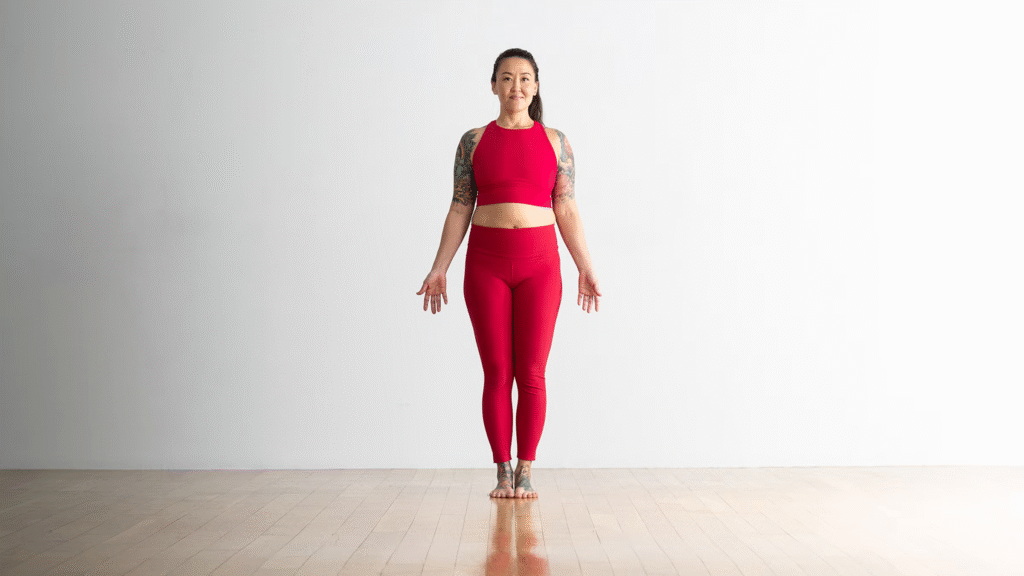
Mountain Pose looks simple, but it is the foundation of all standing yoga postures. By practicing it, you learn how to align your body, distribute your weight evenly, and stand with awareness. This pose improves posture, strengthens the legs, and develops a sense of grounding. It also sets the tone for mindfulness, making it easier to transition into more complex asanas.
Why it matters: Mountain pose is a powerful yoga asana that is a neutral template for all the standing poses. It reflects that when you know how to stand well, everything else like walking or twisting will become efficient. For proper balance, it is important to learn the fundamentals.
Step-by-step guide to perform
- Stand straight with your feet hip-width apart or you can also put them together, whatever suits your stability.
- Make sure that the weight of your body is balanced out on both the legs and all four corners of each foot.
- Now slightly engage your thighs, lift your kneecaps and ensure to not lock your knees.
- Push your tailbone down, keeping your belly slightly in and lift through the crown of your head.
- At last, relax your shoulders and put them away from your ears, and breathe for 5-10 breaths evenly.
Anatomy and practice tip
Tadasana refines foot proprioception and involves the tibialis anterior, spinal extensors, and intrinsic foot muscles. You must practice this daily as a baseline asanas and for resetting your posture.
How to Start Teaching Yoga: Tips for New Instructors
Tree Pose (Vrikshasana)
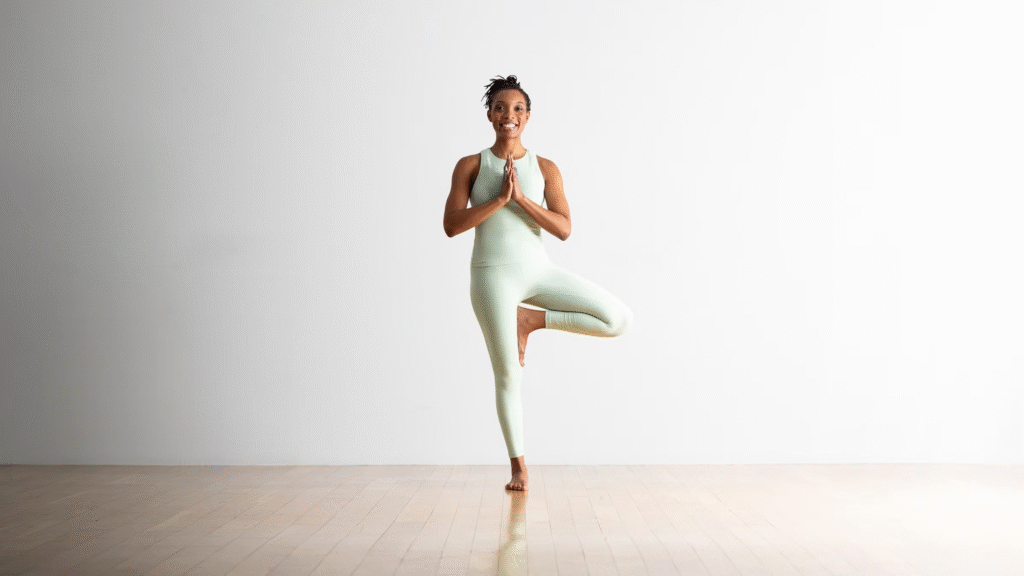
Tree Pose is one of the best balancing postures to build stability in the body and focus in the mind. By standing on one leg, you challenge your coordination and engage the small stabilizing muscles in your ankles, legs, and core. The pose also encourages concentration, patience, and calmness. Over time, Tree Pose helps you feel more centered and confident in both your practice and daily life.
Why it matters: Vrikshasana is an important Hatha yoga pose which is a direct test about the way your nervous system and muscles are coordinating the moment your base becomes small. It teaches single-leg stability and undivided concentration.
Step-by-step
- From the Tadasana pose, shift the weight of your body to one of the feet, say left foot.
- Now bend the other leg’s knee and place the foot on the inside of your calf or thigh. Make sure to not put it directly on the knee.
- Now press the sole of the right foot into the left leg and then press the standing leg into the right leg sole to counter-pressure stabilize the joint.
- Bring your hands together for Anjali Mudra or raise them over your shoulders.
- Hold this pose for at least 30-60 seconds and then switch sides.
Anatomy and practice tip
Vrikshasana is going to challenge your intrinsic muscles of the feet, stabilize the ankle muscles, and train your core for balance. This asana is excellent for someone who wants to practice controlled micro adjustments.
Warrior II (Virabhadrasana II)
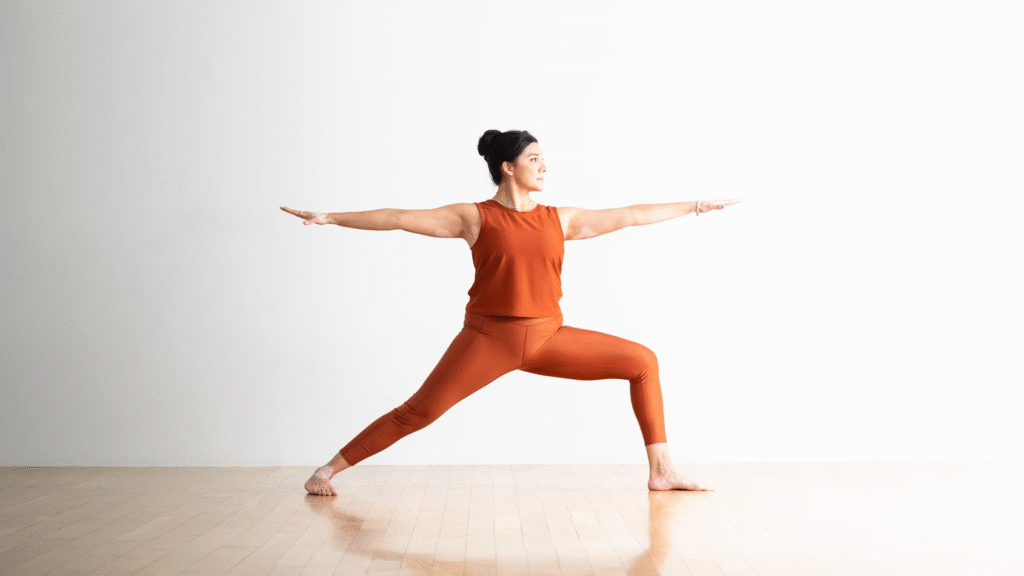
Warrior II is a strong and energizing asana that develops both stamina and stability. Holding this wide-legged posture strengthens the thighs, hips, and shoulders, while opening the chest for better breathing. It encourages resilience, teaching you how to stay steady even when the body begins to tire. Practicing Warrior II regularly also improves focus and builds the mental strength to “hold your ground.
Why it matters: Virabhadrasana II is a powerful yoga pose that helps in building hip, leg, and shoulder endurance along with teaching you to hold balance with a long spine and open chest. It is ideal for someone who wants functional strength and how to distribute efforts across the wide base.
Step-by-step
- Put both your feet wide apart depending on your height.
- Now turn your right foot 90 degrees out and left food slightly inwards.
- Bend your right knee over your ankle for proper alignment.
- Now extend both the arms parallel to the floor, put your gaze at the front and hold this position for 5-8 breaths before switching sides.
Anatomy and practice tip
Warrior II or Virabhadrasana II is an ideal yoga pose for strengthening your hamstrings, glutes, quadriceps, and hip adductors. Practicing this consistently will build symmetrical resilience in you, along with helping you with improving your daily imbalances.
How Much Time Does It Take to Become a Certified Yoga Teacher?
Warrior III (Virabhadrasana III)
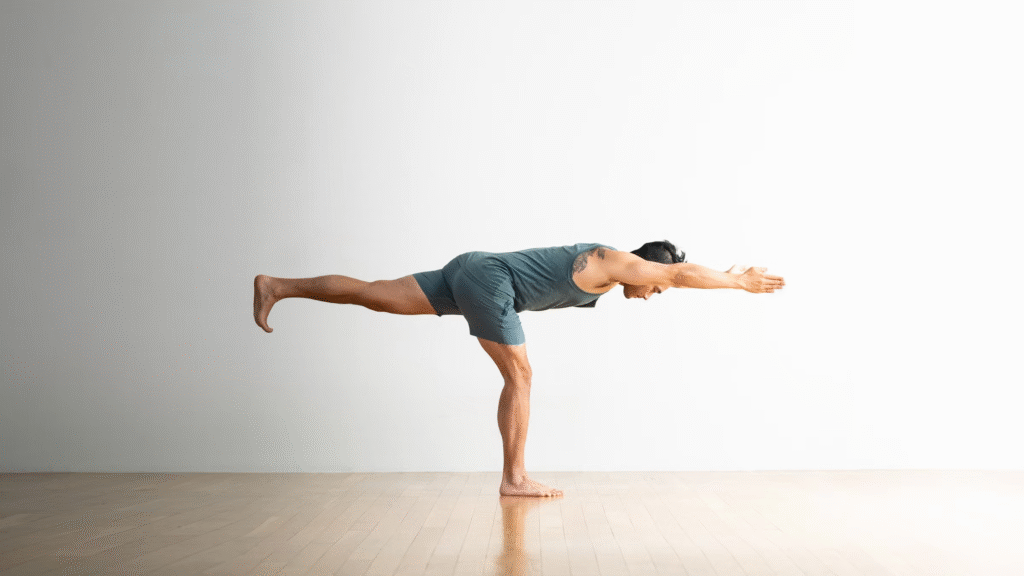
Warrior III is a dynamic balancing pose that demands strength, stability, and concentration all at once. By standing on one leg and extending the body forward, you activate the core, glutes, hamstrings, and back muscles. This pose enhances body awareness and coordination while improving posture. Though challenging at first, it helps build both physical endurance and mental focus.
Why it matters: Virbhadrasana III is also one of the most important asanas for training single-leg strength and teaching full body balance. It can be demanding but is scalable asana.
Step-by-step
- Begin with the Warrior I pose or standing pose.
- Now shift your body weight into your front foot and then lift your other leg bringing your torso parallel with the ground.
- Now, extend your lifted leg backwards, so that arms can reach forward and stay by your sides.
- Straighten your spine from crown to heel and keep your lifted leg active.
- Hold this position for 3-8 breaths, step down, and switch positions.
Anatomy and practice tip
This is an ideal yoga pose that engages with glutes, rector spinae, core stabilizer, and hamstrings. Practice Warrior III poses consistently for short holds and multiple repetitions in order to build good endurance.
Triangle Pose (Trikonasana)
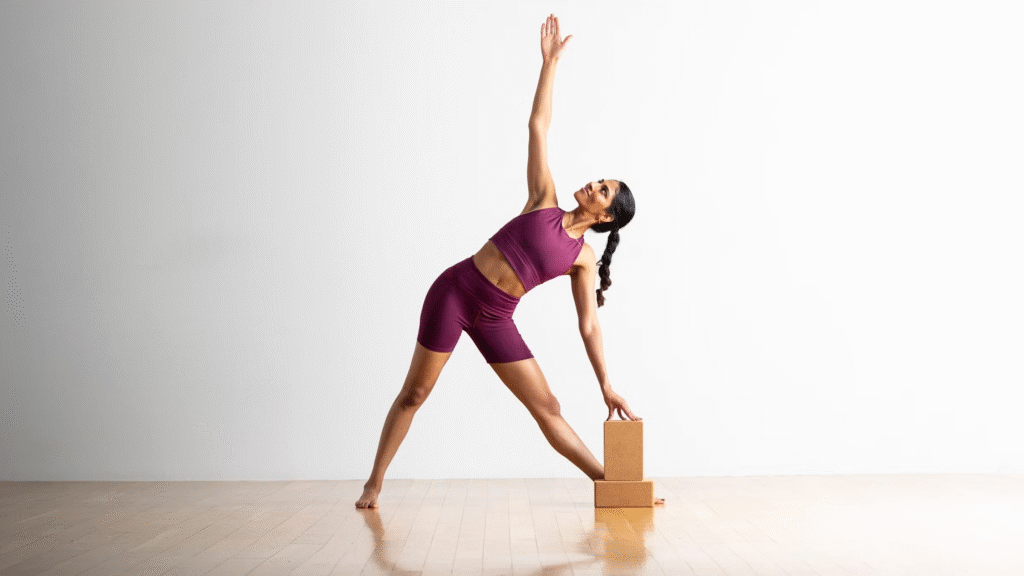
Triangle Pose is a powerful stretch that lengthens the legs, spine, and side body. It teaches you how to rotate the torso while keeping the spine long and aligned, which improves both flexibility and posture. The pose strengthens the legs, tones the waist, and relieves stiffness in the hips and hamstrings. It’s also grounding, helping you feel stable and spacious at the same time.
Why it matters: Trikonasana is helpful in stretching your lateral body and learning to rotate your torso while keeping your spine straight and long. It requires balance as well as hip integrity and keeps your legs active.
Step-by-step
- Begin with a wide-legged position and turn your right foot outwards 90 degrees.
- Extend both the arms parallel, reach forward and lower your right hand to the block to the floor.
- Open your left hip as well as torso, look upwards towards your top hand or in the forward direction.
- Keep your legs active and put your front knee softly engaged, repeat this on the other side as well after holding it for at least 5 breaths.
Anatomy and practice tip
Trikonasana is perfect for targeting quadratus lumborum, adductors, obliques, and hamstrings. It is one of the best Hatha yoga poses to relieve stiffness from your body and train lateral stability.
How to Become a Yoga Teacher: Step-by-Step Certification Guide
Chair Pose (Utkatasana)
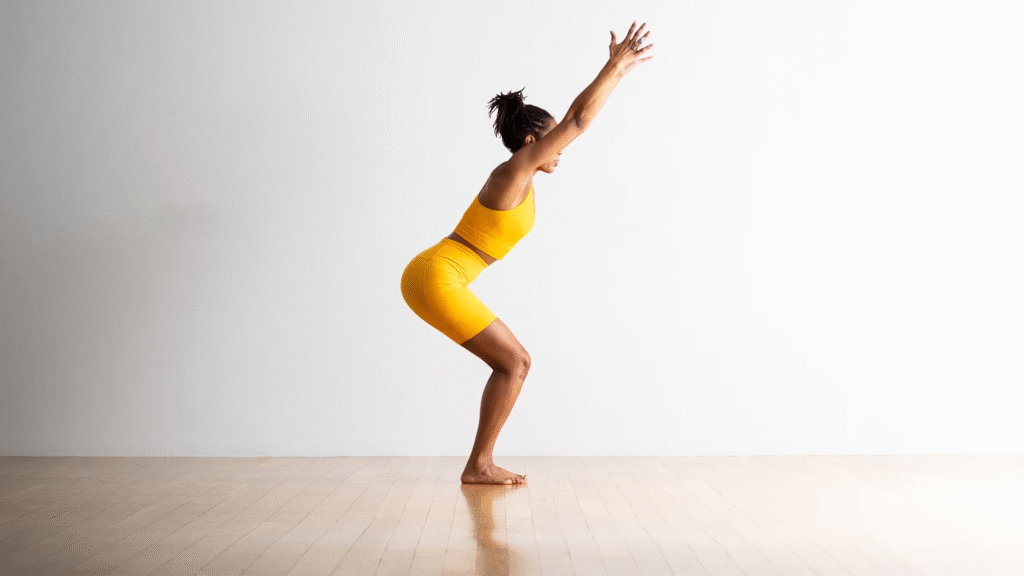
Chair Pose is a strengthening posture that builds heat and endurance in the body. By bending the knees and lowering the hips, you engage the thighs, glutes, and core muscles, while the lifted arms open the chest. It challenges both strength and focus, requiring you to stay calm in a demanding position. With regular practice, it builds stamina and improves balance in everyday movements.
Why it matters: Utkatasana is a strong yoga pose for building the core and leg stability along with testing your dynamic balance. Here, you are in a partially guarded position which simulates holding a weight or lifting demands.
Step-by-step
- Begin with Tadasana and bend your knees while sinking your hips back as if you are sitting on a chair.
- Bring both the arms over your head and keep the hands at the heart centre.
- Keep your weights equally distributed in the heels and knees tracking in the forward direction.
- Now hold this position for at least 5-8 breaths and then rise with control.
Anatomy and practice tip
Utkatasana engages in quadriceps, erector spinae, core, and gluteus maximus. It provides both strength and endurance, when practiced regularly.
Downward-Facing Dog (Adho Mukha Svanasana)
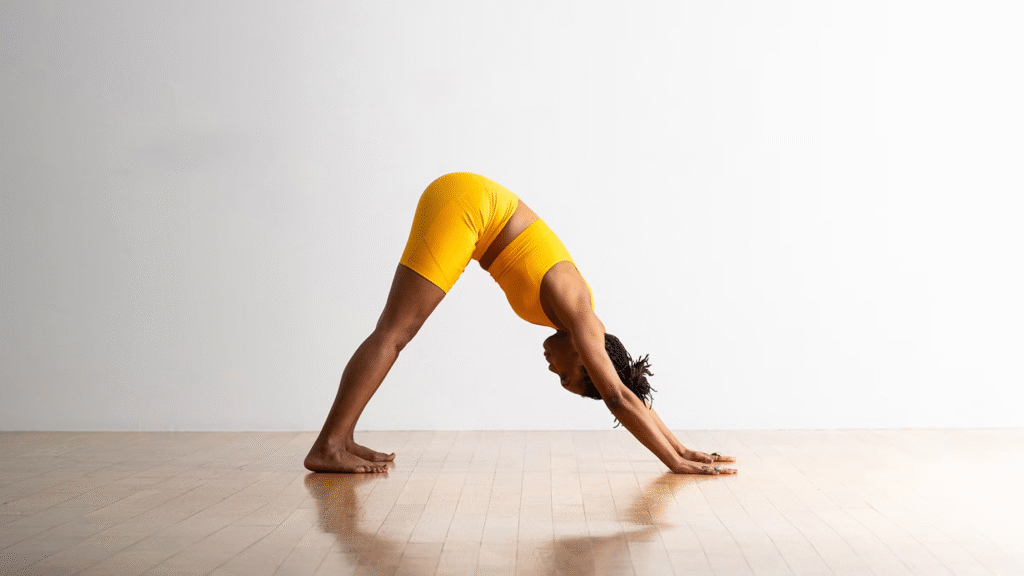
Downward Dog is one of the most well-known yoga poses, offering both strength and restoration. It stretches the hamstrings, calves, and spine while strengthening the arms, shoulders, and core. The inverted position improves circulation and energizes the body, while also calming the mind. This asana is a key transition pose that refreshes the body during any practice.
Why it matters: Downward facing dog yoga pose is considered to be a full-body asana. It is useful in strengthening your arms, shoulders, spine and hamstrings along with building endurance and proper stability.
Step-by-step
- Begin with the tabletop position, lift your hips back, tuck in your toes.
- Now spread your fingers wide and press your palms.
- Rotate your upper arms outwards in such a way that you can broaden your chest.
- Now soften both the knees and push your hips high while keeping your hamstrings tight. Hold this pose for 5-8 breaths and repeat.
Anatomy and practice tip
Downward dog pose is useful in engaging with hamstrings, calves, hand muscles, and the entire body. It is considered to be a traditional asana and the best way to reset your strength as well as restorative moments.
Plank Pose (Phalakasana)
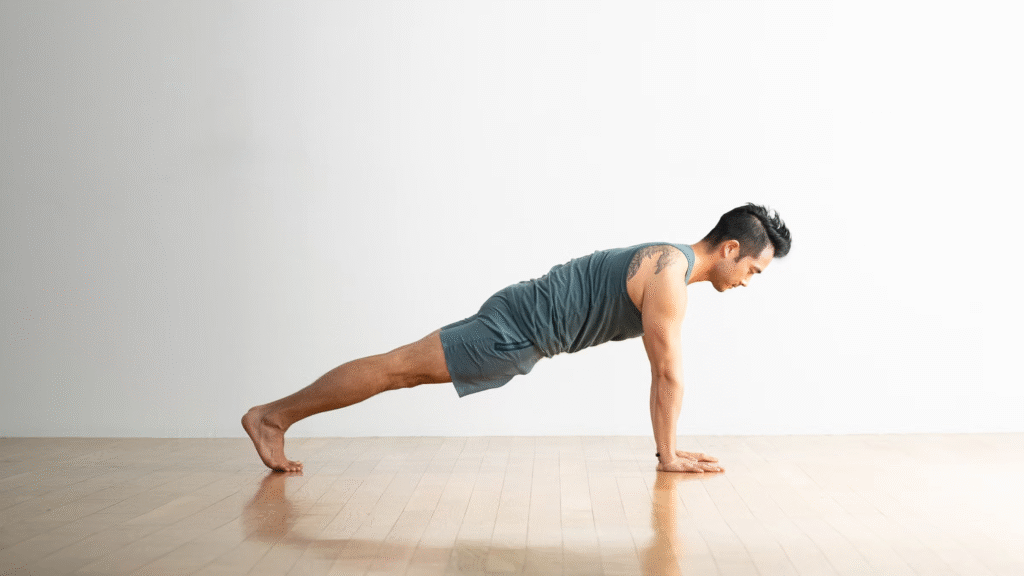
Plank Pose is a straightforward yet highly effective posture for building strength and endurance. It works the core, shoulders, arms, and back while teaching you how to keep the body aligned in a straight line. Holding the pose challenges your stamina and helps prepare you for arm balances and other demanding postures. Over time, it improves overall body stability and mental discipline.
Why it matters: Plank is a direct measure of core as well as shoulder strength. In Hatha yoga style, it is used to build better endurance which is required for sustained alignments in arm-support poses and standing poses.
Step-by-step
- Begin with the tabletop position, put both the feet back so your body forms a straight line from head to toe.
- Then, put your hands under your shoulders and spread your fingers.
- Engage with your core, keep the neck long, and draw your ribs inwards.
- Hold this position for at least 20-60 seconds depending on your body and then repeat.
Anatomy and practice tip
Plank is one of the poses that engages the abdomen, obliques, pectorals, and deltoids. It is useful in building sets instead of one long hold, which ultimately assists in training muscular endurance.
Boat Pose (Navasana)
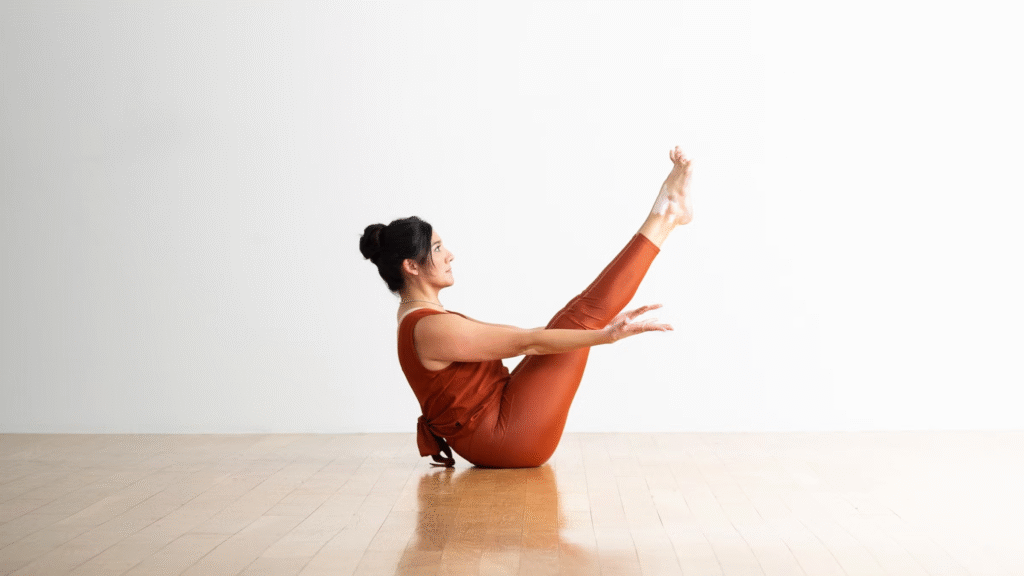
Boat Pose is a classic core exercise in yoga that strengthens the abdominal muscles, hip flexors, and spine. Balancing on your sit bones while lifting your legs and extending your arms requires focus and steady breathing. It not only builds physical strength but also teaches resilience and concentration. Practicing this pose regularly helps improve posture and enhances overall balance.
Why it matters: Boat pose or Navasana is majorly said to be the core posture in Hatha yoga style. It is required for strengthening your abdominals and challenging the balance when your body is sitting on a smaller base.
Step-by-step
- Begin with sitting with your knees bent and both the feet on the floor.
- Now lean back slightly and keep your spine long.
- Lift your feet in order to bring shins parallel to the ground and extend both the arms forward.
- Straighten your legs in such a way that your body forms a V shape. Hold this position for 15-45 seconds and repeat it at least 2-4 times with consistency.
Anatomy and practice tip
Boat pose is essential in targeting iliopsoas, quadriceps, and rectus abdominis. Always remember that shorter duration holds for multiple repetitions are more productive than one long exhaustive hold.
Half Moon Pose (Ardha Chandrasana)
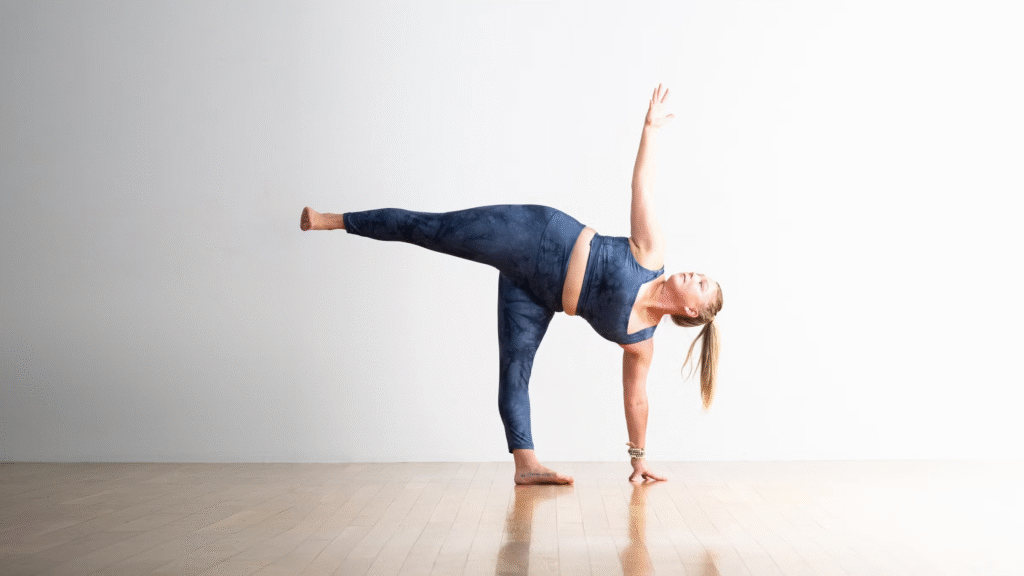
Half Moon Pose is a balancing posture that combines strength, coordination, and openness. Standing on one leg while lifting the other and opening the torso challenges your stability and engages the legs, core, and hips. It also improves flexibility in the spine and chest, creating a sense of expansion. This asana is excellent for cultivating balance both physically and mentally, as it requires focus and calmness to hold.
Why it matters: Ardha CHandrasana is a single-leg balance pose that helps in opening up your side body while building ankle and lateral hip strength. It will teach you proper coordination between standing leg and lifted leg poses with a long spine.
Step-by-step
- Either begin with the Triangle pose or Warrior II pose and shift all your body weight to the front foot.
- Now place your front hand on the ground in forward of the foot.
- Lift your other leg until your body forms a T-shape and open your chest sideways.
- Extend one arm upwards and gaze towards your top hand. Now hold this position for 3-6 breaths, come down with proper control and repeat the pose.
Anatomy and practice tip
Half Moon Pose is best for strengthening your hamstrings, spine, ankles, and glutes. It works better in short and repetitive holds rather than one long hold. Practice this with consistency to develop functional balance in you.


